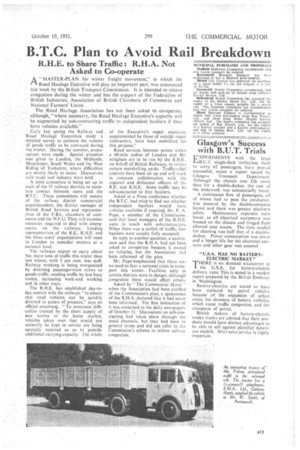Glasgow's Success with B.U.T. Trials
Page 45

If you've noticed an error in this article please click here to report it so we can fix it.
EXPERIMENTS with the large 1.B.U.T. single-deck iroileybus, built to carry 62 passengers, have proved successful, states a report issued by Glasgow Transport Department Although the chassis cost £26 more than for a double-decker, the cost of the bodywork was substantially lower, A continuous flow of passengers, all of whom had to pass the conductor, was ensured by the double-entrance layout and there was greater platform safety. Maintenance expenses were lower, as all electrical equipment was housed on the chassis and hinged flaps allowed easy access. The time needed for cleaning was half that of a doubledecker, Power consumption was lower and a longer life for the electrical contacts and other gear was assured.
"U.S.A. HAS NO BATTERY ELECTRIC MARKET" THERE is no demand whatsoever in 1 the U.S:A. for battery-electric delivery vans. This is stated in a market report prepared by the British Embassy in Washington.
Battery-electrics are stated to have been replaced by petrol vehicles because ._of the expansion of urban areas, the slowness of battery vehicles, which cause traffic congestion, and the cheapness of petrol.
British makers of battery-electric works trucks are advised that their produets should have distinct advantages to be able. to sell against plentiful American models.' After-sales service is highly important.




































































































